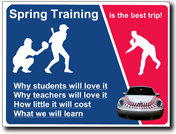
Students will create a written argument persuading their principal to take their class on a trip to the location of their choice. The written argument will then be transformed into a persuasive presentation.
App: Wixie™

Each year, many classes take a class trip as a celebration at the end of the year or to support content and ideas they are learning in the classroom. Your principal has asked you to help determine where you should go for your class trip. Your job is to choose a location and persuade the principal and your fellow students that the destination you have selected is the best choice for the trip. You will research a location, write a written argument, and create a persuasive web presentation to support your argument.
Let your students know they are going to try to persuade the principal where they should take their next class trip. As an entire class, brainstorm destinations that make sense for a class trip. Once the list is complete, have students form teams for each proposed location. Students should spend a few minutes discussing the merits of this location with each other.
Before they can write an effective essay, the students need to gather information about the destination. They will need the following information about the proposed destination to assist them in writing their arguments:
In persuasive, or argumentative, writing, we try to convince others to agree with our facts, share our values, accept our argument and conclusions, and adopt our way of thinking. Discuss the elements of persuasive writing with your students.
Discuss the structure of the essay with your students. Explain that the topic sentence should be a position statement, such as "For our next class trip, we should visit ___." The rest of the first paragraph should state the three main arguments. Each of these arguments should be clarified in a supporting paragraph. The final paragraph should restate the position and summarize the most compelling parts of the argument.
Have students use the information gathered to write an essay convincing others to choose their destination . Students should share their rough drafts with a partner before editing and submitting their finished written argument. Once the final draft is complete, students will work in their teams to combine their arguments into a final persuasive web presentation. Suggest the following presentation format:
Presentations should include concise text that shares only the most important points. This will require students to collaborate, deciding as a group which arguments should be included from each team member's written argument. Each page should include graphics, sounds, narration, and/or video to support the position. You may also want to share tips on effective presentations and presentation design.
Each team should present their project to the entire class body. Invite the principal to make the presentation even more important! The rest of the class can vote on each location with a ballot, with the principal making the final choice in the event of a tie or close results. Within your class, students can rank the projects based the persuasiveness and effectiveness of the presentations.

The notes from their research will give insight to the direction students are heading with their project and assessing these notes prior to any other written work may prove beneficial in the successful completion of the project by students. Each student's written argument can be assessed before the persuasive web sites are completed. During the web site design portion of the project, you will be able to determine students' writing skills, creativity, design and planning skills, and more. The final web sites will help you assess students' understanding how to persuade using language and multimedia elements.
Burns, Deborah. Tips for the Savvy Traveler. ISBN: 0882669710
Fodor's. 1001 Smart Travel Tips. ISBN: 1400012384
Adventure Student Travel https://www.adventurestudenttravel.com/
Writing Persuasive or Argumentative Essays https://www.studygs.net/wrtstr4.htm
Reading Standards
Key Ideas and Details
1. Read closely to determine what the text says explicitly and to make logical inferences from it; cite specific textual evidence when writing or speaking to support conclusions drawn from the text.
Craft and Structure
6. Assess how point of view or purpose shapes the content and style of a text.
Integration of Knowledge and Ideas
8. Delineate and evaluate the argument and specific claims in a text, including the validity of the reasoning as well as the relevance and sufficiency of the evidence.
Writing Standards
Text Types and Purposes
2. Write informative/explanatory texts to examine and convey complex ideas and information clearly and accurately through the effective selection, organization, and analysis of content.
Production and Distribution of Writing
4. Produce clear and coherent writing in which the development, organization, and style are appropriate to task, purpose, and audience.
Research to Build and Present Knowledge
7. Conduct short as well as more sustained research projects based on focused questions, demonstrating understanding of the subject under investigation
Language Standards
Conventions of Standard English
1. Demonstrate command of the conventions of standard English grammar and usage when writing or speaking.
2. Demonstrate command of the conventions of standard English capitalization, punctuation, and spelling when writing.
Vocabulary Acquisition and use
6. Acquire and use accurately a range of general academic and domain-specific words and phrases sufficient for reading, writing, speaking, and listening at the college and career readiness level; demonstrate independence in gathering vocabulary knowledge when encountering an unknown term important to comprehension or expression.
3. Knowledge Constructor
Students critically curate a variety of resources using digital tools to construct knowledge, produce creative artifacts and make meaningful learning experiences for themselves and others. Students:
a. plan and employ effective research strategies to locate information and other resources for their intellectual or creative pursuits.
b. evaluate the accuracy, perspective, credibility and relevance of information, media, data or other resources.
c. curate information from digital resources using a variety of tools and methods to create collections of artifacts that demonstrate meaningful connections or conclusions.
6. Creative Communicator
Students communicate clearly and express themselves creatively for a variety of purposes using the platforms, tools, styles, formats and digital media appropriate to their goals. Students:
a. choose the appropriate platforms and tools for meeting the desired objectives of their creation or communication.
b. create original works or responsibly repurpose or remix digital resources into new creations.
d. publish or present content that customizes the message and medium for their intended audiences.

Follow us on Instagram for daily inspiration

Create a thought web, cluster, flowchart, or other graphic organizer for a lesson
8 first projects to get students using technology
Creative, digital book reviews
Fun and powerful ideas with animated characters

Wixie
Share your ideas, imagination, and understanding through writing, art, voice, and video.

Rubric Maker
Create custom rubrics for your classroom.

Pics4Learning
A curated, copyright-friendly image library that is safe and free for education.

Wriddle
Write, record, and illustrate a sentence.

Get creative classroom ideas delivered straight to your inbox once a month.
Topics